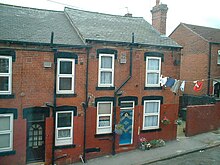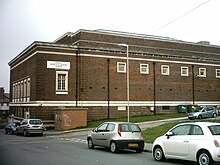Armley
| Armley | ||
|---|---|---|
| Town Street | ||
| Coordinates | 53 ° 48 ′ N , 1 ° 35 ′ W | |
| OS National Grid | SE271335 | |
|
|
||
| Residents | 24,958 | |
| administration | ||
| Post town | LEEDS | |
| ZIP code section | LS12 | |
| prefix | 0113 | |
| Part of the country | England | |
| region | Yorkshire and the Humber | |
| Metropolitan county | West Yorkshire | |
| Metropolitan Borough | City of Leeds | |
| British Parliament | Leeds West | |
Armley is a western part of Leeds , West Yorkshire , England , which is directly connected to the city center. Like Leeds itself and many of its suburbs, Armley experienced strong growth during the Industrial Revolution . There were several textile factories there , one of which is now the Armley Mills Museum. Armley is traditionally a working class residence with numerous back-to-back row houses . Some smaller industrial companies still exist today.
history
In the Domesday Book of 1068 the place is mentioned as "Ristone, Ermelai" with eight households. Today Ristone corresponds to the eastern and Ermelai to the western part of the village.
In 1788, the world's largest wool processing factory was built in Armley Mills. In the 18th and 19th centuries, Armley's factories made a major contribution to Leeds' economic importance. Joshua Tetley, the founder of Tetley's Brewery , came from a family of maltsters in Armley.
JW Roberts' asbestos processing factory was located in Armley from the 1870s until 1956 . A local accumulation of cancers that can still be identified today is attributed to the associated exposure of the population . A lawsuit against the future owners of the production facility, which was initiated in 1993, ended successfully for the plaintiff, but delayed restructuring of the company, a settlement of the case. The story of the case also became the subject of a drama.
Urban regeneration efforts were undertaken from the 1950s through the early 1970s.
In the parish church of St. Bartholomew's there has been an organ since 1879 , which was originally built by the German organ builder Edmund Schulze for Meanwood Towers, a villa in Meanwood , in 1866–1869 and inaugurated there by the organist SS Wesley .
geography
Armley extends from the intersection of the A58, A647 and B6154 in the east at New Wortley to the junction of the A6110 with the A647 in the west, where Bramley joins. It is bounded to the north by the River Aire and to the south by the M621 motorway. The higher southern parts of Armley have good views of the rest of Leeds.
Buildings
Most of Armley's surviving buildings, including churches, schools, shops, and homes, were built in the 19th century. Several churches and cinemas have now been closed and other uses have been made, so two former chapels now house carpet shops.
The original sports and leisure center, which arose from the old swimming pool, was demolished in 2009 and has been replaced by a new building. The local recreation area is Armley Park, also named after an industrialist Gott's Park, which is also home to Gott's Park Golf Club.
Armley Mills Industrial Museum is located in a Grade II listed textile factory on the Leeds and Liverpool Canal .
To the north of Armley is HM Prison Leeds, formerly Armley Gaol, which was built in 1847 in Victorian style.
Many older residential buildings are back-to-back row houses , some of which are being converted into two-sided row houses. Newer apartment buildings were built by private owners in the 1960s. Some high-rise buildings , which in the center of Armley and near Wortley were built to replace older homes, among the highest buildings in Leeds.

traffic
Armley has bus services to Leeds, Bradford , Halifax and Huddersfield . There are only a few parking spaces.
Armley had two train stations. Armley Moor on the Leeds – Bradford Interchange was closed in 1966, Armley Canal Road on the Leeds – Bradford Foster Square in 1965.
Personalities
- Alan Bennett (born 1934), writer, playwright, director and actor
- Barbara Taylor Bradford (born 1933), novelist
- Benjamin Gott (1762–1840), industrialist and philanthropist
- Lily Elsie, actually Elsie Hodder (1886–1962), actress and singer
- Samuel Ledgard (1874–1952), haulier and owner of West Yorkshire's largest bus company at the time
Individual evidence
- ^ Parsons, Edward: The Civil, Ecclesiastical, Literary, Commercial, and Miscellaneous History of Leeds, Bradford, Wakefield, Dewsbury, Otley, and the District Within Ten Miles of Leeds " , Volume Vol. 1. Nabu Press, p. 184 , 185, 187 (accessed July 24, 2015).
- ^ Armley Local History , Yorkshire Evening Post. February 4, 2009. Retrieved July 24, 2015.
- ↑ Tetleys: A gamble that built an empire , Yorkshire Evening Post. November 6, 2008. Retrieved July 24, 2015.
- ↑ Peter Lazenby: Asbestos: the final reckoning . In: Yorkshire Evening Post , October 6, 2005. Retrieved July 24, 2015.
- ↑ Nick Ahad: Echoes of Erin Brockovich as doughty campaigner for justice 'stars' in Dust . In: Yorkshire Evening Post , June 16, 2009. Retrieved July 19, 2009.
- ↑ Graham Barber: St. Bartholomew's, Armley. Brief History of the Organ . Retrieved July 24, 2015: "Written with much reference to The Armley Schulze Organ by Kenneth I. Johnstone"
- ^ John Whitaker: Station Closures . Lost Railways West Yorkshire. Retrieved April 11, 2017.
literature
- Kirkby T. (1901) Armley Through The Camera , Hanson & Oak, Theaker Lane, Armley, Leeds.
- Armley Society (1983) Armley through the Ages , self-published.





